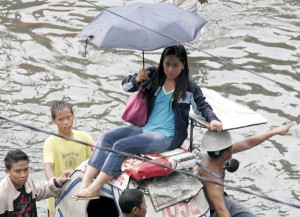Relentless monsoon rains, which have claimed at least seven lives, submerged more than half of Metro Manila on Tuesday.
Water engulfed entire homes and vehicles in large parts of the metropolis, trapping many people and forcing tens of thousands into evacuation centers.
At least 60 percent of Metro Manila was flooded on Tuesday morning, with some places enduring waters climbing as high as 2.1 meters (seven feet), an official with the Metropolitan Manila Development Authority (MMDA) told a briefing.
While no one had been reported killed in Metro Manila, four more people were confirmed to have drowned in flooded farming provinces to the north, said Reynaldo Balido, a spokesman for the government’s disaster management council.
This brought the confirmed death toll from two days of flooding across Luzon to seven.
The economic toll also started to grow, with the Philippine Stock Exchange, government offices and schools in Manila closed for a second consecutive day.
Many domestic flights at the Ninoy Aquino International Airport were cancelled, while international flights were delayed on Tuesday morning. Flooded roads to the airport were impassable.
The weather agency warned the rain would continue through Tuesday, issuing its top level red alert for Metro Manila and neighboring provinces.
The red alert means “serious flooding” is likely in low-lying areas, and more than three centimeters (1.8 inches) of rain is expected every hour.
The heavy rains were due to the seasonal monsoon being exacerbated by Storm Maring, which was hovering to the north of Luzon.
The National Disaster Risk Reduction Management Council (NDRRMC) reported that 347 areas in Metro Manila, Southern Tagalog and Central Luzon were affected by floods.
Local governments intensified rescue and evacuation operations on Tuesday.
In Makati City, Vice President Jejomar Binay joined his son, Mayor Jejomar Erwin Binay, in rescuing residents in Barangay Magallanes.
Mayor Binay said flooded areas in Makati included Barangays Rizal, Cembo, Comembo, Batungbangkal, Pio del Pilar, La Paz, San Antonio, Singkamas and Tejeros.
In Pasay City, some residents in Malibay were forced to climb rooftops after the Maricaban Creek flowed over.
Mayor Antonio Calixto said the Philippine Air Force sent a truck to Barangay 183 to help pluck residents from rooftops.
In Marikina City, the local government imposed a forced evacuation after the Marikina River reached its critical level before 3 p.m. Tuesday.
Marikina Mayor Del de Guzman said alert level 4 has been raised as the river level reached 18 meters.
In Muntinlupa City, the local government declared a state of calamity due to massive flooding.
Mayor Jaime Fresnedi said 7,705 families had been affected by floods in the city and 138 of them were in evacuation centers.
In Taguig City, 2,216 families were staying at 26 evacuation centers and in Las Pinas, at least 1,500 families were affected.
Sixteen barangays in Parañaque City were flooded, which was aggravated by high tide.
Government offices in Metro Manila stayed for the second straight day on Tuesday because of the floods.
Presidential spokesman Edwin Lacierda said the Office of the President suspended work in Metro Manila, heeding the recommendation of the MMDA and Philippine Atmospheric, Geophysical and Astronomical Services Administration (Pagasa).
In the outskirts of the metropolis, Cavite province is among the worst hit by floods.
Two of the new flood fatalities were from the province.
A nine-year-old boy and a male caretaker drowned after a dike was breached by floodwaters in Barangay Tres Cruses in Tanza.
Hunger also stalked Cavite residents because many public market and grocery stores remain closed.
“We cannot buy food since most of the markets and even supermarkets remained closed,” a resident from Noveleta town said.
Some of the residents could not buy food because banks have closed and Automated Teller Machines (ATMs) have run out of cash.
Cavite Governor Jonvic Remulla said among the stricken towns were Kawit, Imus, Noveleta, Tanza and Rosario.
“In Rosario and Imus, the flood water was from 12 to 18 feet so the people were forced to stay on rooftops,” Remulla told a radio interview.
In Bacoor City, the Coastal Road and Aguinaldo highway were littered with parked vehicles.
Around 20,000 people were evacuated and two flood-related deaths were reported in the province.
In Tanza, three houses were carried away by the raging Amaya River.
The MMDA sent two rescue teams to Imus and Rosario.
MMDA Chairman Francis Tolentino said one 10-man team equipped with two rubber boats was sent to Rosario. The other, which was aboard two trucks, went to Imus.
The Philippine Coast Guard also joined rescue operations in Cavite, concentrating on the towns of Rosario, Kawit, Imus, and Noveleta.
The Philippine National Police (PNP) was directed by Interior Secretary Mar Roxas to help rescue and distribute relief parcels to flood victims in Metro Manila and nearby provinces.
La Mesa Dam let out excess water after the level reached 80.29 meters, and a Red alert was raised, calling for the evacuation of nearby residents.
Ipo, Binga and Ambuklao Dams each opened two gates and Magat Dam, one.


